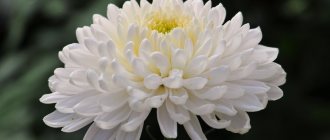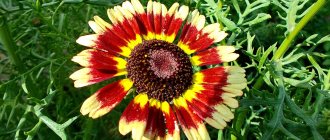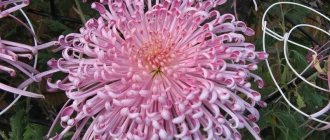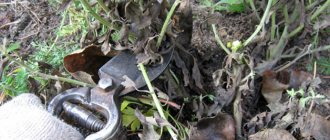Step-by-step cutting and rooting technique
For those who are planning to cut a flower they like from a chrysanthemum bouquet for the first time, but have never done this before, there are very simple and understandable instructions for this procedure.
You should not blindly expect that an unpretentious chrysanthemum will be able to easily and quickly root all cut cuttings. In order to grow a truly beautiful and viable flower, you need to carefully select the material for germination and subsequent planting in a pot or flowerbed. An ideal cutting must meet the following requirements:
- the absence of any signs of rot over the entire area of the stem;
- strong and healthy appearance;
- specimens that are too young or too old are not suitable;
- average stem thickness and sufficient rigidity.
For further germination, it is recommended to choose cuttings that have lateral branches, because they can send out roots and multiply faster than others.
Important! Material from weak, diseased or too old chrysanthemum bushes should not be used as cuttings. They either will not be able to produce roots at all, or will rot immediately after planting in open ground.
Selection of chrysanthemum stems for cuttings
The selected planting material is soaked (the lower part) in a solution that stimulates root formation, such as:
- "Epin";
- "Zircon";
- "Kornevin".
The best time for cutting chrysanthemums and then rooting the cuttings is spring, starting from mid-March and ending in late May. The plant enters early flowering in March or April, and late and middle flowering in May.
The stemness and size of the plant's flowers should also be taken into account. Thus, multi-stem chrysanthemums with large and small inflorescences are recommended to be propagated in March, single-stem chrysanthemums - in April-May, and also to be propagated in the first ten days of June
The duration of rooting of cuttings in the first three months of the year is from 20 to 25 days, in warm April or May - about 2 weeks.
Rooted chrysanthemum cuttings
The specific timing of rooting is determined by air temperature (optimally 18-23 degrees) and substrate humidity.
At the very bottom of the pot it is necessary to pour a layer of drainage from bricks ground into crumbs, fine construction sand or expanded clay. This layer will help protect the delicate root system from rot.
The soil for the soil is light, slightly acidic or neutral pH, it is advisable to mix it with a small dose of fertilizer.
Important! The diameter of the pot must be at least 28 centimeters; there must be several holes on the bottom side (on the bottom) to drain excess moisture. Before directly planting the cuttings, it is recommended to thoroughly water the soil to saturate it with moisture.
You should also loosen the soil in the pot and remove all weeds along with the roots.
If you plan to grow a new chrysanthemum bush in a flowerbed, then you should select loose, moisture-permeable and nutrient-rich soil in a sunny and slightly elevated area. In such conditions, the flower will not stretch shoots and bloom at the wrong time.
Cuttings that have successfully completed the rooting stage can be safely planted in a pot or open ground.
In the flowerbed they should not be placed too close to each other, the step is from 0.3 to 0.6 meters. Compact planting is not allowed, otherwise the flowering plant will not develop. The recommended depth of the holes is no more than 1.8 cm. The root system of the chrysanthemum bush grows parallel to the soil, so you should not bury the cuttings too deep into the soil. Around the stem placed in the hole, the substrate is carefully compacted and watered.
Planting cuttings in the ground
Advice. After planting all the material, the surface of the flower bed is spilled with a weak solution of potassium permanganate to disinfect and protect against bacteria.
The seedlings are protected from wind blowing with the help of a fence; it can also be used as a support for thin stems. A few hours after planting, young chrysanthemums may weaken, but with proper care they quickly recover.
On the same day, the growing point of the seedlings is removed; this is called the first pinching. After a few (2-3) weeks, pinching is carried out again, and the apical part of the shoot with a pair of nodules is cut off. This is necessary to form a beautiful bush shape.
For the first few days, it is advisable to shade the planted cuttings with a small canopy for speedy establishment.
When to plant cuttings in open ground
In the autumn, it is better to complete planting in the ground before mid-September. If this fails, it is better to postpone the event until spring and send the seedling itself to rest in a pot in a dark, cool place.
It is best to plant in a flowerbed on a cloudy or even rainy day. If it is sunny outside, it is better to plant cuttings in open ground early in the morning or late in the evening so that they do not come under direct sunlight.
Stunningly beautiful chrysanthemums are not so difficult to propagate by cuttings. If, for example, a chrysanthemum has given roots in a vase, the question of how to plant it in a pot or flowerbed is solved by obtaining a cutting from it and its subsequent rooting. With the correct selection of soil and proper care, you can get a new full-fledged chrysanthemum bush from a flower you like in a bouquet.
Cutting process
It is necessary to distinguish between actually green and actively growing cuttings. The latter take root faster, but require more careful care. They are cut from the tops of young shoots - actively growing parts of the plant on which lignification has not yet begun.
Green cuttings are obtained from the top of young shoots after the spring wave of growth has died down. The stem at this time is already beginning to become lignified. During rooting, such a cutting coarsens even more.
Slicing
Early, mid and late flowering varieties are cut at the same time. Cuttings are cut when at least 4 leaves grow on the shoots. It is not recommended to take weak, fattening or shortened shoots - they will later grow into poorly decorative plants.
Cuttings can be carried out at a later date, using the apical parts of previously rooted young chrysanthemums obtained during winter cuttings.
Rules for cutting cuttings:
- 1The shoots are divided into segments using a cutting board.
- 2The length of the cutting should be 4-5 cm.
- 3Each of them should have two internodes.
- 4 Properly cut cuttings should not have a hard or soft base. In the first case, rooting will be slow, in the second the stem will rot.
- 5C cuttings do not cut off the leaves - they are needed for quick rooting. The lower plates are removed, since after planting they still rot.
1 - cuttings of small-flowered multiflora chrysanthemums, prepared for planting; 2 - rooted cuttings after 20 days
Green cuttings can be cut as soon as there is a decrease in the rate of shoot growth. For open ground chrysanthemums this is the beginning of June. The shoots are cut in the morning, immediately placed in a bucket of water or in a plastic bag and taken into the shade.
Chrysanthemum shoots are fragile and delicate, so to cut them it is better to use a safety razor blade inserted into a special frame so that only one side of the tool is working. The sharp edges of the razor allow you to get perfectly smooth cuts - in this case, rooting proceeds faster. The instrument must be periodically disinfected so as not to transfer viral diseases from one shoot to another.
Timing of cuttings
Chrysanthemum cuttings are carried out from March to the end of May. Large-flowered plants grown in a single-stem culture can be taken from April to early June.
The first cuttings from the mother plant can be obtained as early as March, using shoots emerging from the ground from the roots. Cuttings from shoots that appear on old stems should not be taken.
Is it possible to root a chrysanthemum from a bouquet?
There are several ways to propagate a flower. Propagation of chrysanthemums by cuttings is one of the most common methods. To do this, several flowers are selected from the bouquet. The success of the event depends on the correctly selected plant and planting algorithm.
The advantage of rooting is the ability to select a crop with certain varietal characteristics: a clear example allows you to find a specimen that is suitable in color and shape
Which chrysanthemums can be propagated by cuttings from a bouquet
The flower's ability to take root is high, so propagating the plant is easy. But if the specimen for cuttings is chosen poorly, then the chrysanthemum will not take root.
You need to choose the following flower:
- there is no rot on the stems of the crop;
- cuttings are strong, young, green in color and of medium thickness;
- The plant has lateral branches.
Important! It is recommended to purchase flowers from domestic producers: the plants are adapted to the local climate. Imported bouquets are often treated with chemicals that protect the buds from premature withering, but prevent the successful rooting of the crop
Using cuttings
Gardeners recommend propagation by cuttings at the end of winter (February) and before the beginning of summer. This method is reliable and productive.
The first cutting method
The bush is pruned low in the fall, then it is dug up and stored indoors, where it is dark and cool. The dug out bush is sprinkled with sand. So you can save it until the end of winter until the month of February, not forgetting about regular watering.
At the end of winter (February), the plant is moved to another room with an average temperature of at least 15 degrees Celsius and planted in fertile soil. The planted bush is watered and after a week, it is fed. Ammonium nitrate is suitable for this purpose. Experts recommend lighting plants so that the rays of light fall on them from above. After active growth begins, you can start cuttings.
Propagation of chrysanthemums by cuttings
The cuttings are cut with a sharp knife, leaving about 10 centimeters in length and three to four nodes. Nodes are the places where leaves are attached to the stem. On the part that remains, you need to save about 2 - 3 leaves so that shoots begin to appear in a few weeks. They will be used in cuttings.
The cut cuttings are carefully examined; the strongest ones, those with elastic bases, are left for propagation.
Before planting in the soil, the lower leaves of the cuttings are torn off, the upper ones must be shortened by a third of the leaf plate.
Planting of cuttings occurs at a temperature of 18 - 20 degrees Celsius; the day before they are placed in containers filled with soil mixture. The mixture is prepared by combining sand, garden soil with humus (proportion 2:1:1). On top of the soil is sprinkled with a three-centimeter layer of river sand.
The container with cuttings should be covered with film so that the distance from the film to the top of the bush is at least 30 centimeters. Waiting to take root. Watering occurs carefully, by spraying the soil cover in clear weather 2 - 3 times a day.
After 2 - 3 weeks, when the plants have taken root, the film can be removed from them. After seven days, the seedlings must be transplanted into containers with a soil mixture obtained by combining turf, humus and sand (2:2:1).
When the cuttings grow 5-6 leaves, pinching is carried out to speed up growth with the development of the bushes. The cuttings need to be fed twice a month, for this you need to use a solution of saltpeter. In sunny times, the plant needs to be shaded.
Before planting chrysanthemum bushes in open soil, they need to be hardened off (10 - 12 days before transplanting). During the hardening process, the plant is taken out to an open area and covered with film at night. After the frosts have passed, the seedlings are planted in the prepared area.
Second way
This method is used in open ground conditions (May – June). The chrysanthemums that you have selected are well covered with spruce branches in the autumn, with preliminary hilling in humus mixed with soil and sand. In the spring, the insulating cover is removed and the humus is leveled. Starting in April, when the plant reaches 13–15 centimeters in height, cuttings are cut into 6–7 centimeters in length.
The cuttings are planted on a raised bed in fertile garden soil, with river sand sprinkled on top.
Then all this is covered with a film stretched over an arched frame. When it's warm, the film needs to be removed. If you comply with the growing conditions, then by the end of May - beginning of June the cuttings can be transplanted into flower beds.
On the balcony
An excellent method for city residents who bought a multiflora chrysanthemum in a pot. It is good because you can see wintering plants every day and monitor their condition.
Any glazed balcony or loggia or veranda is suitable for wintering. That is, any bright and cool place in which the temperature remains 3-10°C in winter. Moreover, quite wide variations in this range are allowed; nothing bad will happen with a cooling of up to 1°C or with a warming of up to 15°C.
Also, on a balcony or even on a cool windowsill, multiflora can overwinter in the form of cuttings, which need to be rooted in advance - at least in early autumn.
Chrysanthemum cuttings in spring
Mother bush. For spring cuttings you will need a queen cell from which you will
Mother bush
cuttings are prepared. It must be prepared in the fall. Before frost, cut off the entire above-ground part of the chrysanthemum bush down to the ground. Dig it up and place it in any suitable sized container, a large pot, bucket, basin, etc. Cover the roots with soil or sand and place it in a cold, damp cellar. If there is no cellar, use any room where the temperature does not exceed +5 - 7C. At higher temperatures, shoots may appear prematurely.
Watering the queen cell during wintering. The soil should be slightly moist throughout the winter. In a damp cellar, watering may not be necessary. But you can’t overdry it, or the plant may die. If the soil is dry, you need to water it little by little.
When to start cuttings. Spring cuttings of chrysanthemums are usually carried out in March. In mid-February, move the mother bush to a warm room and water it well. After 7 - 10 days, young shoots will begin to appear.
Prepared cuttings
How to prepare cuttings. Wait until the height of the shoots is 8 - 10 cm. Cut them so that two pairs of leaves remain on the remaining stumps. Then new shoots will grow on them faster, which can also be taken from cuttings. Small shoots should not be cut off; they are not yet ripe and may rot. Remove the bottom pair of leaves from the prepared cuttings. There is no need to trim the top leaves.
Landing. Before planting, the prepared soil must be shed with water. In a common cuttings, the cuttings are planted at a distance of 5 cm between plants and to a depth of 1.5 - 2 cm. You can plant one at a time in cups, or three cuttings in pots at once. In the latter case, in a few months you will get a very nice, blooming chrysanthemum bush (bottom photo).
If the cuttings are kept indoors, they should be covered with film. When grown in
Planting in pots
The greenhouse does not require a film cover.
When propagating chrysanthemums by cuttings, the use of root-forming preparations is not necessary.
How to care. Care consists of daily spraying with water and watering as needed. It is advisable to maintain the temperature within 16 - 18C. Rooting occurs in 20 - 25 days.
When young shoots appear, the film can be removed. After rooting and the beginning of growth, feed young chrysanthemums with complex min. fertilizer once every 10-15 days.
If a chrysanthemum has given roots in a vase
If the gifted bouquet sits in a vase for quite a long time, the conditions and water are suitable, the plant can easily start the process of growing a root system, and completely unexpectedly for the owners of the bouquet. In this case, you can germinate the “distinguished” plant and then plant it in open ground or a separate pot, depending on the species.
Chrysanthemums taking root in a vase
The flower that has given roots must be cut to a length of about 10 centimeters; the remaining parts of the stem can also begin to take root and grow into full-fledged plants. After which the cutting must be placed in a pot with soil, which must be thoroughly disinfected, otherwise the young sprout will die.
The pot should be kept on the sunny side of the house, while strictly monitoring the humidity of the substrate and preventing it from drying out. At first the sprouts will be long and thin, but with proper care they will grow stronger and bloom after a while.
Propagation of bouquet chrysanthemums
The flower is usually cut from October to November, but is it possible to carry out the procedure at any other time of the year if you were given a bouquet of chic chrysanthemums of a rare, incredibly beautiful variety? It is possible, because cuttings from bouquet flowers not only take root well, but also repeat the varietal characteristics. Of course, you can search for the variety you like in catalogs, order seeds or seedlings. The search will require time and financial costs, but why if the planting material is already at hand.
How to choose a flower and what to do with it
If the bouquet contains stems with small shoots, use them first. Cuttings from such shoots take root faster and grow well. If there are no such flowers, take any, but prepare as many cuttings as possible, this will increase the likelihood of obtaining planting material. It is not necessary to cut fresh stems; on the contrary, it is better to wait until the flowers begin to fade. You cannot take shoots with obvious signs of disease, there is a risk that they will not take root, and indoor plants can pick up the disease.
All inflorescences, as well as the bottom of the cutting (about 4 cm) need to be cut off. Remove all leaves and side branches from the remaining stem, do not cut directly at the stem, leaving small stumps. Place the cuttings in settled or boiled water, add a little root formation stimulant and an activated carbon tablet, it will kill microorganisms that provoke the development of various putrefactive processes.
The roots will emerge in about 3-4 weeks, if they still do not appear and the cutting has begun to rot, cut the lower part of the stem to healthy tissue, rinse the glass thoroughly, replace the water and add activated carbon again. As soon as the roots appear, the chrysanthemum should be immediately transplanted into a pot with soil. Don't worry if the stem starts to dry out, this is not a sign of spoilage.
Preparing containers and soil
For only rooted cuttings, you should choose small pots; they may not be deep, but they must be wide.
In such a container, the chrysanthemum root will gradually occupy a new area, there will be no accumulation of excess moisture in unaffected areas of the soil, which means the risk of rotting or the appearance of pests will be minimized. You need to replant the flower into a large pot when it has grown well. Attention! When planting cuttings, do not use garden or garden soil; it may contain pest larvae and infections.
Chrysanthemums prefer loose, nutritious soil; poor, dense or heavy soil is not suitable for them. If you do not have the opportunity to purchase special soil for chrysanthemums, prepare it yourself. Mix store-bought all-purpose soil for indoor, garden and garden crops with perlite, sand and coconut fiber. Adjust the amount of ingredients at your discretion to ensure a light and loose mixture.
Planting and caring for rooted chrysanthemum
Plant the cuttings very carefully so as not to damage the roots.
Pour soil into the prepared container up to half the volume, moisten it a little, place a twig in the middle and gradually cover it with soil. Lightly tamp down the soil and water again with a little water. At first, it is better not to touch the chrysanthemum, cover the cutting with a jar or polyethylene, and periodically moisten the soil. After a month, the seedlings can be fed with nitrogen fertilizers (a tablespoon of dry raw material per 10 liters of water), they will activate growth. The young bush should be given the lightest window sill; in the spring, the seedling should be shaded from the sun's rays. When the cutting takes root and actively begins to grow, pinch the top a little, the plant will send out side shoots, and after 2 months, prune again. At first, the chrysanthemum needs light, even in winter; after planting in open ground, the flower adapts and begins to enter the dormant stage.
How to propagate chrysanthemum by cuttings in the fall. Rooting chrysanthemum cuttings in a new way
Have you ever had cases when well-tested methods for growing plants suddenly stopped working? I have yes. When I first started working with chrysanthemums, the rooting of their cuttings went well, the survival rate was almost 100%. I dug up queen cells at the end of February, germinated them at home, two or three weeks later I cut the cuttings, planted them in cups, and a month later I received excellent rooted cuttings. But then something happened and the survival rate went down sharply. It was insulting and annoying, but I continued to work according to that method.
One day my neighbors came to me for unrooted cuttings. It was April, and I advised them not to bother with the cups, but to plant the cuttings directly in the greenhouse and cover them from the sun with a light covering material. The neighbors listened, did as I recommended, and what do you think? Literally all of their cuttings took root; after planting in open ground, their chrysanthemums grew quickly and bloomed at the same time as mine, which I rooted a month earlier. This made me think: is it worth engaging in that labor-intensive process, which, moreover, has ceased to give a good result?
This season I decided not to rush into digging up the queen cells. I waited until they woke up on their own, dug them up at the end of March, planted them in large nurseries and kept them in a greenhouse. Thus, I got rid of the problems associated with placing chrysanthemums at home and cleaning up the soil that spilled during work.
In the greenhouse, the queen cells sprouted very quickly. The other day they grew to the size required for cuttings, so today I decided to do this work. The weather was favorable, it was cloudy, and in the coming days they promise partly cloudy skies, which means the sun will not be so scorching.
Here is one of the nurseries with a queen cell for cuttings:
I cut the cuttings and remove excess leaves:
I plant it in the ground that I recently prepared for growing early cucumbers. I dug up, made a ridge and covered it with black mulch covering material, cutting it in the middle for planting seedlings. But the seedlings are still on the way, and the ground has not warmed up enough for the cucumbers, so I, having calculated approximately where the cucumbers from the cups would be planted, planted chrysanthemum cuttings in the gaps. There will be enough space for everyone, while the cucumbers grow, the cuttings will have time to take root under the mulch, which will perfectly maintain the necessary humidity.
A rope is stretched on top of the ridge at a height of 1 meter, through which I throw white covering material. It will protect the cuttings from low temperatures at night and from the scorching sun during the day. This way I provided a good microclimate for rooting. Results will be visible in 3-4 weeks, so continue.
Planting chrysanthemums
Chrysanthemums do not like the slightest shading and moisture retention, so the place for them should be sunny and at least slightly elevated. This is a guarantee that the shoots will not stretch or change the time and period of flowering. However, the root system of chrysanthemums is superficial, so the soil should not be overdried.
The ideal soil for them is loose, moisture-permeable, with the optimal amount of various nutrients. If the soil in the garden is dense and infertile, before planting the cuttings, add a little peat, compost or rotted manure to the soil, but do not overuse them, otherwise the plants will become overly tall to the detriment of flowering. Add a small amount of coarse sand to the soil for drainage. The soil mixture is preferably neutral or slightly acidic.
Planting chrysanthemums
Immediately after planting in the ground, the first pinching is carried out - the growing point on the plant is removed. 3 weeks after planting, the upper part of the shoot with 2-3 nodes is broken off - the second pinching. The first days after planting, artificially shade the seedlings so that they do not suffer from bright sunlight. The best option is non-woven material, but it is advisable that it does not come into contact with the leaves.
The procedure for planting chrysanthemums is not at all complicated, but some rules must be followed. The condition and beauty of the chrysanthemum depends on their conscientious implementation.
Selecting a location
Spring planting of the crop is carried out in early June, when the threat of return frosts has completely passed. If planting flowers is planned for autumn, then it is necessary to calculate the time so that at least two weeks remain before the first frost. Only in this case will the chrysanthemum have time to take root and grow stronger.
When looking for a plot for a flower garden, you need to choose an elevated place, where there is a lot of light and little wind. Chrysanthemum really does not like stagnant water and shade. As for the soil, the plant needs a slightly acidic, neutral environment. Clay and sandy soils require additional fertilizer.
Planting chrysanthemums
When applying fertilizers, it is necessary to take into account that it is impossible to apply unrotted manure; it is better to opt for humus and vermicompost
However, you need to apply fertilizing with caution, without overdoing it, otherwise, instead of flowers, the plants will begin to intensively develop green mass
How to plant a crop
Attention! If after planting the plants are watered with rootstock, rooting will take place much faster. Simultaneously with planting, pinching is carried out: removal of the growing point
Side shoots are also pinched to grow a dense chrysanthemum bush. This manipulation is carried out for small-flowered varieties. Growing large flowers involves removing side shoots
Simultaneously with planting, pinching is carried out: removing the growing point. Side shoots are also pinched to grow a dense chrysanthemum bush. This manipulation is carried out for small-flowered varieties. Growing large flowers involves removing side shoots.
For tall varieties, stakes, mesh, and wire structures are used as support.
You should always water the chrysanthemum abundantly, but make sure that the water does not stagnate. With a lack of moisture, the flower stems become woody and the flowers become dull.
Important! Water only at the root, with rainwater, or settled water, with the addition of drops of ammonia
Top dressing
Feeding for chrysanthemums is necessary. Mineral and organic fertilizers should be alternated. During the season, 3-4 feedings are carried out.
The first feeding is needed with ammonia nitrogen so that the crop grows green mass. To stimulate intensive flowering of chrysanthemums at the time of budding, phosphorus-potassium fertilizers are offered.
Plants should not be planted too tightly; the distance between them should be at least 35-40 cm. When planting, the tops of the plants are pinched, stimulating branching. The planted crops are fed twice a month and watered as needed with warm water.
Similar agricultural technology is applicable to Korean varieties of perennial chrysanthemums. They grow in one place for 2-3 years. Then they require a transplant. Large-flowered chrysanthemums are grown mainly as an annual crop and, most often, in a greenhouse.
So, we tried to find the answer to the question of how to grow chrysanthemums from a bouquet, and we hope that this publication will help beginning gardeners.
About limited watering of overwintered chrysanthemum mother plants
I would like to draw attention to the common mistake of over-watering, which many gardeners make when they take out multiflora queen cells from the basement in the spring, which are already beginning to germinate.
The mistake is that overwintered chrysanthemum bushes begin to be watered abundantly after storage. This often leads to the death of multiflora due to soaking of the rhizome.
To prevent this from happening, you need to water the mother chrysanthemum bushes only after the soil has completely dried out. And at the same time, do not spill the entire earthen lump, but take literally half a cup of water and splash it over the surface of the substrate in the pot.
We suggest you familiarize yourself with Chest pain
Autumn cuttings: the “classic” method
And for adherents of “traditional” vegetative propagation by green cuttings who want to propagate a valuable variety. What should be a candidate for cuttings:
- the shoot is selected to the required length. With earlier rooting, longer ones are harvested, 7-8 cm, sometimes up to 15 cm. With later rooting, 5-6 cm long;
- shoots that have 2-3 internodes and 3-4 leaves are subject to cuttings - this is the minimum;
- there should be no lignified tissue on the base - the shoot should not be too soft, but not rough either.
Cut long pieces - up to 15 cm, using the middle part of the shoot for cuttings. It is better to make a cut above the kidney obliquely, above the kidney - straight. The top sheet is cut in half, the bottom sheet is removed. After removing the leaves, it is useful to leave the cuttings in a growth stimulator for 10-12 hours.
The root primordia are formed in 2-3 weeks, and the shoot primordium will form in four to five weeks. Next, the chrysanthemum seedlings are planted in a greenhouse in a permanent place or the rooted cuttings are stored until spring.
As you can see, autumn cuttings of chrysanthemums differ in approach, but not in complexity. The disadvantage of the method is lunges at low temperatures and with excess moisture. The survival rate of young bushes is low. When cuttings are taken late in open ground, they are planted only in southern conditions.
For whom is autumn cuttings suitable? First of all, for those practicing commercial cultivation of the last flowers of autumn out of season - in closed ground in greenhouses and greenhouses. Enthusiasts looking for new methods of working with plants. Practitioners who carry out cuttings with subsequent planting in the spring. And to everyone else who loves chrysanthemums.
Quote from Tanya_Labazina's message
Propagation of chrysanthemums by cuttings.
Propagation of chrysanthemums by cuttings is carried out from January to mid-June - for large-flowered varieties, and from late February to the end of June - for small-flowered varieties.
Cuttings of chrysanthemums at home proceed as follows. During flowering, mother plants with the best varietal characteristics are selected. The selected bushes must be healthy, flowering profusely, and not affected by diseases and pests. The quality of future plants depends on this.
Cuttings can be made not only from mother bushes, but even from a bouquet, although the likelihood of rooting of such cuttings will be somewhat lower, because It is unknown how much time has passed since the flowers were cut.
At the end of flowering, the queen cells are cut low, carefully dug up and transplanted into a pot. Pots with chrysanthemums are placed for the winter in a cool, dark place with a temperature of 5-8 degrees
They stay like this until about February.
The best time to propagate chrysanthemums from cuttings is March-April.
At the end of February, the bushes are transferred to a warm room with a temperature of 15 degrees. Chrysanthemums are watered and fed with ammonium nitrate every other week. Soon the active development of shoots begins, which means you can start cutting chrysanthemums. Old stems are removed, leaving no stumps above the ground.
Cuttings are cut with a sharp, clean knife. They should have 3-4 leaf nodes and reach a length of 7-10 cm. The cut is made under the node. The cuttings must have an elastic base that is not softened or lignified. Otherwise they will rot or take root poorly. For planting, you will need boxes with nutritious soil (a mixture of sand, garden soil and humus 2:1:1). 2-3 cm of coarse sand is poured on top.
The tip of the cutting is dipped in a growth stimulator and stuck into the box at a slight slope. The cuttings are planted at a distance of 3x4 and to a depth of 1.5 cm so that the tip is in a layer of sand and not soil.
Cuttings can be rooted in disposable cups or peat tablets. Some gardeners place cuttings in water to which activated carbon is added.
The boxes are covered with film and left in a bright place at a temperature of 18 degrees. Water them very carefully, spraying the soil 2-3 times a day only in sunny weather. Excessive moisture can cause rot.
After 2-3 weeks, the cuttings will take root and their growth will become noticeable. This means you can remove the film and plant it in small pots.
2 parts of humus and turf soil and 1 part of sand are poured into the pots. When 5-7 leaves appear, the seedlings are pinched for the best development and branching of the bush.
They pinch the second time when the side shoots reach 10 cm. This will help to form a beautiful, neat bush that is resistant to unfavorable climate and blooms well.
Twice a month, seedlings are fed with ammonium nitrate (20 g of nitrate per 10 liters of water). 10 days before transplanting into open ground, chrysanthemums are hardened off. They are placed on the balcony, covered with film at night. Or they are taken to the country and placed in a greenhouse or on the terrace. If the threat of cold weather has passed, they are planted in a permanent place.
Caring for the Multiflora chrysanthemum
Plants are not too demanding to care for and require standard measures.
Watering
Chrysanthemum is very moisture-loving, so it must be watered abundantly before flowering.
The frequency of moisture application depends entirely on weather conditions. The most frequent and abundant watering is carried out on hot and dry days. In rainy weather, irrigation activities are not required. A good result in maintaining soil moisture is shown by systematic loosening of the soil around the bushes.
Feeding
The spherical chrysanthemums of the “Multiflora” series are not very demanding on soil fertility in the flower garden and the quality composition of fertilizers. However, as a result of insufficient introduction of the main components of nutrition, as well as a deficiency of microelements, growth and development of buds very often slow down, and chlorosis of the foliage is observed. An excess of fertilizers causes fattening of the bushes.
Fertilizing plants, if the planting hole is properly filled with fertilizers, can be done once during the growing season. It is recommended to use a solution of mullein or bird droppings for this.
Features of growing chrysanthemum "Multiflora"
This plant absolutely does not require any special procedures for its formation.
, which is determined by the peculiarities of genetics. It is not advisable to grow a flower in one area for more than two seasons. Long-term cultivation in the same place often provokes degeneration and loss of the plant’s unique shape. Therefore, once every three years the bushes should be removed from the ground and replanted.
Wintering in open ground
If the plant is grown in the southern regions with warm winters, then the bushes do not need to be covered; it is enough to hill them up and sprinkle dry leaves, wood shavings or other natural loose and light material on top. Many flower growers in the southern regions do not prune “Multiflora” after flowering, and over time the leaves and stems of the plant fall off, forming a fairly effective shelter.
Of course, such a variety of chrysanthemum as “Multiflora” is an ideal potted crop; it is best grown in large flowerpots. Containers with plants for the winter period must be brought into a relatively warm room. When growing in flower beds, “Multiflora” must be covered for the winter.
These plants winter successfully in open ground only if preparatory measures are carried out correctly.
After the plants have flowered, they should be trimmed to a height of 20 cm. The root shoots can be left untouched. Trimmed bushes need to be mulched with pine needles or straw, and then covered with humus or peat chips. For effective snow retention, you should cover the plants with spruce branches.
General idea of the plant
Chrysanthemums are herbaceous or semi-shrub plants. Depending on the variety, the height of chrysanthemums is 20-80 cm. The inflorescences of the most varied colors look great against the background of dissected, jagged or simple leaves of a light or dark green hue, which are placed on the stems of the plant in a regular order.
Currently, more than 100 varieties have been bred, differing in bush height, inflorescence structure, color and flowering time, so choosing a variety that would look great in single compositions or on an alpine hill is not difficult, and you can propagate your favorite plant using one of the following ways.
To form a bush of the correct shape and produce flowers in accordance with varietal characteristics, the tops of the central buds and lateral shoots of plants must be pinched in a timely manner.
For large-flowered varieties, the top of the central shoot is pinched with the appearance of 8 leaves, after which lateral shoots develop, of which 2-3 strong ones are left, and the rest are removed. Pinching is done as needed 1-2 times a week to form one large flower on each stem.
Periodic pinching affects not only the formation of the bush, but also the development of the plant as a whole, since the stepsons only draw a large amount of nutrients from the bush.
Thus, propagation of chrysanthemums can be done not only from a bush growing in the garden, but also from a presented bouquet, and the whole process is shown more clearly in the video - propagation of chrysanthemums.
Feeding
In the vegetative growth phase (during the growth of green mass), fertilizing with a predominance of nitrogen (N) is used. For the formation of the root system, cell walls, as well as for better nitrogen absorption, it is recommended to add calcium (Ca) to the nutrient diet. For example, in the form of calcium nitrate, which contains both calcium and the necessary nitrogen.
In the reproductive phase (when the process of laying buds is underway), the composition of fertilizers is changed to phosphorus-potassium.
The interval between feedings is 7-10 days.
How to plant a chrysanthemum by dividing a bush
Division is the second most popular method after cuttings on how to grow a chrysanthemum. It is advisable to divide bush chrysanthemums every 3 years. If this is not done, flowering will not be abundant and weak. Before growing chrysanthemums by dividing the bush, the plant must be dug up, divided together with the roots into several parts, the soil removed from the roots (if it is sandy) or washed off with water and planted. The number of planting units that can be obtained from one plant depends on its age and characteristics of the variety. On average, a bush that is 3 years old produces 5-6 strong, healthy cuttings.
As a rule, nurseries sell plants propagated by cuttings and division, since most chrysanthemum varieties are hybrids that are not so easy to grow from seeds.
During the season, dividing the bush can be done at any time, even during the flowering period, if necessary. But it is best in June, when young shoots are actively developing. Green sprouts of chrysanthemums very quickly produce new roots. To help them, it is necessary that the soil in which the sprouts are planted is moist until they take root. Therefore, if there is not enough planting material, you can plant even broken or rootless cuttings.
The resulting cuttings are planted in holes previously dug and filled with humus soil and watered generously. Subsequent care for them is exactly the same as for last year's chrysanthemums. Flowering of young bushes is observed already in the year of transplantation, but the timing of its onset may shift and occur 2 weeks later than that of the mother plant.
Chrysanthemum multiflora: nuances of cultivation
The plant is unpretentious and easy to care for. At the same time, due to the fact that it is necessary to know some of the characteristics of chrysanthemums and take them into account when growing, an ignorant grower, ignoring them, risks losing the plant.
The main requirement is to cover the flowers even in the south, if the winter has little snow and the temperature drops to -15 and below for more than 2-3 days per season.
It should also be taken into account that chrysanthemums cannot be planted near fences and walls, because the fence disrupts adequate lighting, which does not allow the plant to form a regular spherical bush.











